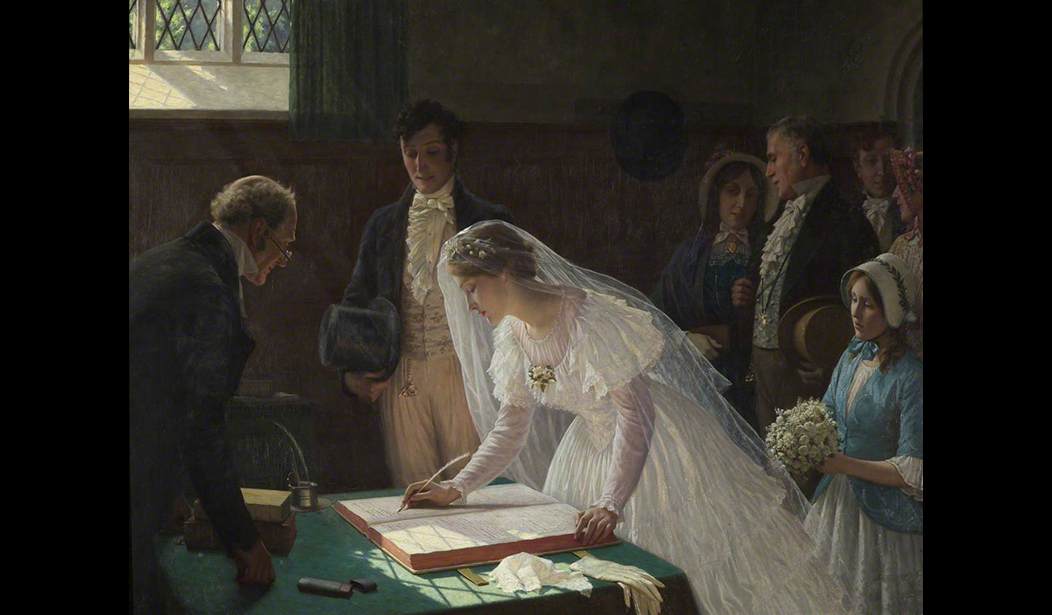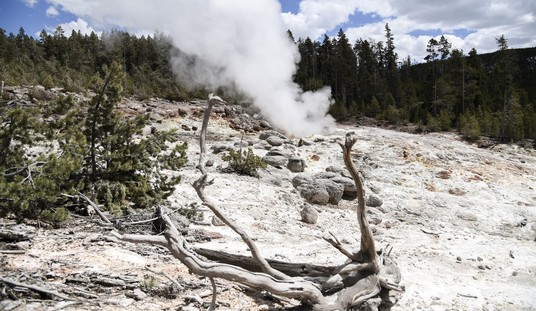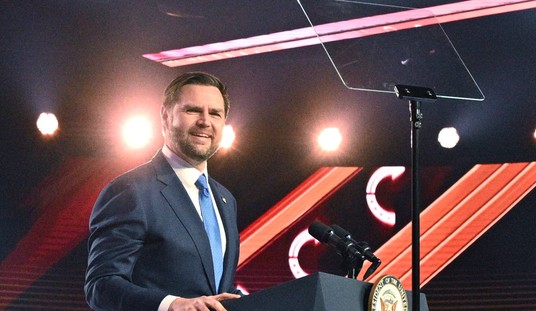Marriage is one constant in humanity. It's always been there and always will be. Not everyone gets married; I have a couple of friends who are committed old bachelors, and they intend to stay that way; they like it and that's the truth. But most people do marry; it's the usual form. Marriage may be to join two lives together to start a family, it may be a move by two older people for ease and companionship in their golden years. People have as many reasons to get married as there are people, and marriage has taken many forms; polygamy, for instance, used to be common in some parts of the world and still is in parts of Asia and Africa.
In the Western world, though, marriage rates are declining. So are rates of childbirth. Many in the younger generations are not only not getting married, but they aren't having kids. One might point back to the "Good Old Days" when marriage rates were higher as an example - but if you look back through history, marriage wasn't always a pleasant thing. A recent Cato Institute piece presents some interesting information on marriage in the pre-industrial world, and it ain't pretty:
...the truth is that people in the preindustrial past faced few possibilities regarding marriage. The number of potential partners in one’s tiny village was low, and the few available choices might all be one’s cousins, increasing the risk of birth defects in any resulting children.
Peasants “married fellow villagers and were so insular that local dialects were often incomprehensible to men living only a few miles away,” according to the historian William Manchester. Travel was rarer, and communities were more secluded than a modern person could easily imagine. By the 18th century, little had changed. “Most villagers married people from within 10 miles of home,” as the historian Kirstin Olsen noted.
That's a hard thing for people in our modern times to wrap their heads around. I grew up in Iowa, my wife grew up in Maryland, we met in Colorado, and now live in Alaska. But in the pre-industrial world, travel was risky, even dangerous, and beyond the reach of almost everybody.
So, yes, your options were limited, and that didn't always result in a peaceful marital home life:
Given the highly limited pool of marriage partner choices, perhaps it is unsurprising that many people seemingly settled for spouses ill-suited to them and that “much of the satirical literature of the 18th century,” in Olsen’s words, “lampooned marriage as a hell or prison sentence for one or both partners. The poem Wedlock by the Englishwoman Mehetabel ‘Hetty’ Wright (1697–1750), herself pressured into a loveless marriage with a plumber, paints a typical picture: ‘Thou source of discord, pain and care, / Thou sure forerunner of despair, / Thou scorpion with a double face, / Thou lawful plague of human race, / Thou bane of freedom, ease and mirth, / Thou serpent which the angels fly, / Thou monster whom the beasts defy’” … you get the idea.
These days, in the Western world - the civilized world - most marriages are marriages of love. They don't always stay that way, but they start that way. But throughout human history, many - very likely most - marriages were arranged by parents. We see that today, even in the civilized world; how likely is it that the United Kingdom's King Charles' first marriage was, if not arranged, then at least it was something into which both parties were pressured?
So, it's not surprising that people found creative ways to get out of a bad marriage:
Many unhappy marriages turned abusive. Courts tolerated physical abuse in most cases, and men often had the legal authority to commit their wives to insane asylums. Domestic violence was celebrated in songs such as the upbeat wife-beater’s anthem, The Cooper of Fife, which I have written about previously. An abused woman’s best hope was often not legal recourse but the possibility that a male relative, neighbor, or sympathetic passerby might notice her plight and act on her behalf. Olsen notes that sometimes “neighbors intervened when men beat their wives … as a saddler did in 1703, telling the abusive husband, ‘you shall not beat your wife.’”
Of course, some of this was almost certainly attenuated by the fact that most women had fathers, brothers, and cousins who didn't approve of someone slapping their daughter/sister/cousin around and would retaliate. But that's not a societal solution. And women had their ways of dealing with such abuse:
Women, for their part, were also known to engage in criminal cruelty toward their husbands, such as by lethally poisoning them. Sometimes, these murders were committed in retaliation for domestic abuse. Aqua Tofana was a poison discovered in 17th-century Sicily that was notoriously sold through much of Italy by women to other women seeking to end their husbands’ lives discreetly. Hundreds of victims (mainly men murdered by their wives) are estimated to have perished from the colorless, odorless poison, the precise ingredients of which are today unknown. The poison has been called the “bottled revenge of the 17th-century wife.”
Marriage is, yes, a lasting and defining institution. But while it's not perfect today, a look through history reveals that it never was. People are imperfect, and we'll never have perfect institutions until we have perfect people, which, candidly, ain't going to happen. As marriage goes, though, most of the civilized world has a pretty good bead on it, to the extent that the younger generations are still engaging in it.
And that's the rub.
See Related: Happy Valentine's Day! Five Great Romantic Songs for Your Valentine's Day Celebration
On This Valentine's Day, Data Shows Conservative Women Are Having a Much Better Time
Marriage among young people has a primary purpose: Starting a family. That's the one historical constant; marriage is the primary institutional setup for bearing and raising children. There are any number of studies showing children are healthiest and happiest in a traditional family setting, although I question the cause-effect in some of these; it seems likely not that the traditional family structure in and of itself is beneficial, but that it's the kind of people inclined to a traditional family structure tend to do better as parents and role models - thus producing healthier kids.
I can only speak from my own experience, but I grew up in a traditional family, and my folks were awesome; my childhood was safe, secure, and happy. Not every family is so lucky, but that doesn't mean the institution overall isn't effective.
Some things are traditional for a reason.
Declining marriage and childbirth rates are, of course, still a concern. The future belongs to those who show up for it, and much of the youth of the Western world, as well as in places like Japan and China, are opting out. That's a problem.
But we should be cautious about pointing to history for institutional role models. The "good old days" weren't always all that good.














